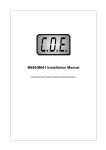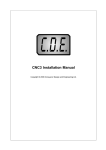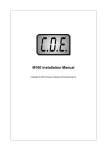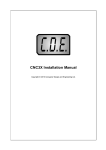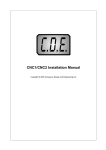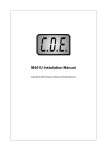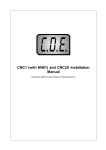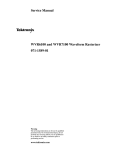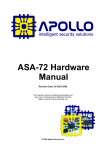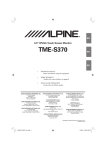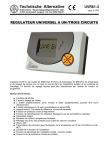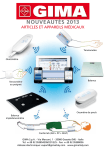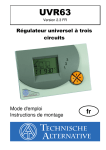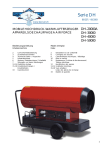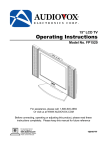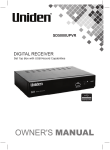Download M401 Installation Manual - Conqueror Design & Engineering Ltd
Transcript
M401 Installation Manual Copyright © 2013 Conqueror Design and Engineering Ltd. M401 Installation Manual Copyright © 2013 Conqueror Design and Engineering Ltd. All rights reserved. Any dispute about the use of this software and/or hardware or of these terms and conditions shall be resolved or arbitrated under English Law. Manuals and accompanying documentation may not be copied or printed for the purposes of training, advertising, promotion or any other use without the permission of Conqueror Design and Engineering Limited. Permission to copy and print manuals and documentation for personal use is granted to the owner/user of the software supplied. All trademarks are acknowledged to be the property of their respective owners. This manual produced on 26/06/2013. Warranty This software and/or hardware and accompanying documentation are provided 'as-is' and are not warranted to be fit for any specific purpose or usage. The use of this software and/or hardware is undertaken at your own risk and Conqueror Design and Engineering Limited will not be responsible for any loss of data, time or income resulting from the use of this software and/or hardware. Warranty Updates are available from the website. We recommend getting the latest manual updates when working with the product. Contents I Table of Contents Part 1 Disclaimer of Liability and Limitation of Warranty 1 Part 2 Introduction to the M401 card 2 1 Components ................................................................................................................................... of the M401 card 3 2 RS232 ................................................................................................................................... Serial Interface 4 3 Connector ................................................................................................................................... for Stepper Motor Drives 5 4 Relay ................................................................................................................................... drivers 6 5 Connectors ................................................................................................................................... for Ready LED, Jog-buttons, Limit-switches, the Encoder and the Safety Circuit 7 Quadrature-encoders ......................................................................................................................................................... 9 6 Spindle ................................................................................................................................... Speed Output 11 Part 3 Manual Operation without a Computer 13 Part 4 Connecting motor drive cards 14 1 X641SC ................................................................................................................................... stepper-motor card interface board 15 Part 5 Mechanical/Mounting Details 17 Part 6 Appendices 18 1 Command ................................................................................................................................... Set 18 2 G-Codes ................................................................................................................................... 20 3 M-Codes ................................................................................................................................... 21 4 Control ................................................................................................................................... Parameters 22 5 Firmware ................................................................................................................................... upgrade/repair 26 Index 27 Copyright © 2013 Conqueror Design and Engineering Ltd. I 1 1 M401 Installation Manual Disclaimer of Liability and Limitation of Warranty Where the M401 card is supplied as a component and not as part of a complete control system it is assumed that the purchaser has sufficient electrical and electronic knowledge to handle the component competently. It is further assumed that the purchaser has sufficient knowledge of safe working practices and the relevant Health & Safety regulations which apply to working with electrical and electronic systems to work safely with the component. Conqueror Design and Engineering Limited will not accept any liability for any damage to systems or personnel that may result from the incorrect installation or usage of the hardware supplied. Nor will Conqueror Design and Engineering Limited replace or repair any supplied equipment that has been damaged as a result of such incorrect misuse or installation. Copyright © 2013 Conqueror Design and Engineering Ltd. Introduction to the M401 card 2 2 Introduction to the M401 card The M401 card has been designed to control CNC lathes, milling machines, PCB drills, routers, etc. In fact any machine which has 1, 2, 3 or 4 stepper motor driven axes. Copyright © 2013 Conqueror Design and Engineering Ltd. 3 2.1 M401 Installation Manual Components of the M401 card The card is supplied with EaziCNC 3 editing and programming software for Microsoft Windows. Please refer to the separate EaziCNC 3 manual for details on operating the EaziCNC 3 software. Copyright © 2013 Conqueror Design and Engineering Ltd. Introduction to the M401 card 2.2 4 RS232 Serial Interface Pin Signal 2 Receive Data (RCD) 3 Transmit Data (TXD) 5 Ground The serial port is configured as a standard PC AT 9-pin port. A standard PC-AT to PC-AT serial cable (a cross-over cable) can be used. The default protocols are 115,200 baud, 8 data bits, no parity and 1 stop bit. The board will use XON/XOFF flow controls by default. Copyright © 2013 Conqueror Design and Engineering Ltd. 5 2.3 M401 Installation Manual Connector for Stepper Motor Drives Pin Function 1 VCC (+5-volts). 2 Ground (0-volts). 3 STPX. Clock/Step-pulse for X motor. 4 STPY. Clock/Step-pulse for Y motor. 5 STPZ. Clock/Step-pulse for Z motor. 6 STPE. Clock/Step-pulse for E/U motor. 7 DIR. Motor step direction. Shared by all drives. 8 ENABLE. Used to idle the stepper motor drives when not in use. 9 RE1 - digital output #1 10 RE2 - digital output #2 Connector MOTORS at the centre right of the M401 card can be used to attach separate stepper motor drive cards. If the stepper motor drive card STEP1 or STEPHP1 is/are used then the connections to the cards can be made via a straight ribbon cable "bus" and the cards can be configured to identify as X, Y, Z or U. If other drive cards are used then it will probably be necessary to use a terminal block or Y-cables to connect the shared signals to the different cards. The digital outputs RE1 and RE2 are also available on this connector. These outputs may be used to drive or sink 25 mA @ 5 Volt. Miniature 5 volt relays (or solid-state relays) can be used to boost the control of these outputs up to any level. Copyright © 2013 Conqueror Design and Engineering Ltd. Introduction to the M401 card 2.4 6 Relay drivers Pin Function 1 12-volts 2 Relay #1 Output (sink). Usually used for spindle on/off 3 Relay #2 Output (sink). Usually used for coolant on/off The M401 card has 2 relay drivers each capable of driving a 150 milli-Amp 12-volt load. The REL connector is used to connect external relays or loads to the board. The relays are interlinked with the safety circuit (the STP connector). If the safety circuit is broken then the supply to the relays will be interrupted and they will turn off. Copyright © 2013 Conqueror Design and Engineering Ltd. 7 2.5 M401 Installation Manual Connectors for Ready LED, Jog-buttons, Limit-switches, the Encoder and the Safety Circuit The connectors for the Ready LED, jog-buttons, limit-switches and the safety circuit are located along the top and bottom edges of the board... In each case the square pad located inside each connector indicates pin1 (this is also marked by a triangle). RDY1 - Ready LED Pin Function 1 connect to the Anode of an LED 2 connect to the Cathode of an LED The Ready LED allows an off-board LED to show the same status as the on-board RDY LED (the green LED). The external LED will be driven at approximately 2.5mA. X+, X-, Y+, Y-, Z+ and Z- Axis Jog-button and BN1 connectors Pin Function 1 Button signal. Short to pin 2 to activate button (i.e., connect the switch across the 2 pins) 2 Ground STP - Safety circuit connector Pin Function 1 Safety circuit +. 2 Safety circuit LIMX, LIMY and LIMZ Limit-switch connectors Pin 1 Function Positive travel limit signal. Short to pin 2 to activate limit (i.e., Copyright © 2013 Conqueror Design and Engineering Ltd. Introduction to the M401 card 8 connect the switch across the 2 pins) 2 Ground (0-volts). 3 Negative travel limit signal. Short to pin 4 to activate limit (i.e., connect the switch across the 2 pins) 4 Ground (0-volts). The LIMY connector can be used for threading support (or synchronized drive on a mill/ router/wire-eroder). Two optical sensors can be connected to the +limit and the -limit. A single pulse per/rev sensor should be connected to the Y+ limit and a multi-slot sensor to the Y- limit. If only synchronized drive is to be used then only the multi-slot sensor needs to be connected. The power for the sensors can be drawn from the V+5 connector or the ENC connector and either pin 2 or 4 of the LIMY connector can be used for GND/0V. If the threading function is to be used then the Y-limits should be disabled in the configuration. The encoder connector can be used for attaching a quadrature encoder for jog-wheel use... ENC encoder connector Pin Function 1 +5V 2 Quadrature A signal 3 Quadrature B signal 4 Ground (0-volts). Copyright © 2013 Conqueror Design and Engineering Ltd. 9 2.5.1 M401 Installation Manual Quadrature-encoders Quadrature-encoders output 2 pulse trains, A and B, which are out of phase. The 'quadrature' in the name is derived from the fact that there are 4 states for the 2 signals to be in... A-off-with-B off, A-on-with-B-off, A-on-with-B-on and A-off-with-B-on. The sequence of these states determines the direction of rotation of the encoder... For feedback from the motors optical encoders are usually used... ...because they place no load on the drive system and can cope with the high speeds that motors Copyright © 2013 Conqueror Design and Engineering Ltd. Introduction to the M401 card 10 and shafts may turn at. The encoder pictured is a rotary encoder with a slotted disk... the disk determines the resolution of the encoder... in this case 400 counts/rev. Optical encoders also come in strip or linear forms and there are other types of non-contact encoders that can be used (such as capacitance strips or magnetic proximity switches). For the hand wheel a mechanical (cheaper!) encoder/switch can be used... ...these operate using a wafer switch but provide the same quadrature outputs as an optical encoder... they are just not suitable for high-speed or long-life applications. Another advantage of these mechanical encoders is that they often have detents (a cogging feel as they are rotated). The encoder shown is a Bourne ECW1J-B24-AC0024 it provides 96 counts per revolution and is the encoder we use for the hand wheel on the CNC1, CNC2 and CNC3 boxed controllers. Copyright © 2013 Conqueror Design and Engineering Ltd. 11 2.6 M401 Installation Manual Spindle Speed Output Pin Function 1 Analogue positive supply. AN+ 2 Analogue signal. ANS 3 Analogue negative supply. AN- 4 Spindle on signal. SO+ 5 Spindle on common. SO- The M401 has an optically isolated analogue output for spindle speed control and an isolated switch for spindle on/off control (SPINDLE). The optically isolated analogue output is suitable for use with cards that either have provision for a DC signal to control the speed or use a low-current potentiometer to set the speed. It is not suitable for thyristor type controllers which pass a substantial part of the motor current through the potentiometer or for controllers which use an AC signal to set the speed. Most DC speed controls and AC/3-phase inverters are compatible with the circuit. The spindle on/off function is for use with those speed control cards which have a low-voltage, low-current logic signal for enabling the motor. If a voltage higher than 24-volts or a current more than 40 milli-amps needs to be switched then a relay connected to the relay drive RE1 will need to be used. The card also has a PWM output which has the raw pulse-width-modulated speed control signal at TTL levels... Pin 1 Function PWM output (TTL level) Copyright © 2013 Conqueror Design and Engineering Ltd. Introduction to the M401 card 2 GND Copyright © 2013 Conqueror Design and Engineering Ltd. 12 13 3 M401 Installation Manual Manual Operation without a Computer If no computer is attached the machine can be used in a rudimentary manner using the following jog-button and BN1 (button 1) combinations. The jog-buttons operate as normal in manual mode when BN1 is not pressed. Keys pressed Action BN1 & X+ Enter manual mode. BN1 & X- Exit manual mode. BN1 & Y+ Turn spindle/spindle-relay on BN1 & Y- Turn spindle/spindle-relay off BN1 & Z+ Toggle rapid and feed modes. BN1 & Z- Toggle Coolant on/off If no button has been pressed for several minutes the machine will be switched out of manual mode. When in manual mode the status LED (the green LED) with flash to indicate that the jog-buttons are active. Copyright © 2013 Conqueror Design and Engineering Ltd. Connecting motor drive cards 4 14 Connecting motor drive cards The M401 can be connected to up to 4 stepper motor drive cards. The connection for additional drive cards is a 10-pin IDC connector. If our STEP1 or STEPHP1 cards are used then a simple ribbon cable with bussed connectors can be used to connect the cards together... ...each STEP1 or STEPHP1 card is then set to be either X, Y, Z or E/U using the jumpers (JP1) on the card. N.B. If using STEP1 or STEPHP1 cards remember to remove the jumpers JP3 so that the +5 volt lines of all the cards are not connected. This will reduce heat-dissipation in the voltage regulators. If 3rd party cards are used then you may find it convenient to use the optional OPTOCARD1 opto-isolator card or the X641SC stepper converter to simplify splitting the step-clock and direction signals between several cards. Copyright © 2013 Conqueror Design and Engineering Ltd. 15 4.1 M401 Installation Manual X641SC stepper-motor card interface board The X641SC card is useful for interfacing to 3rd-party stepper motor drive cards. The X641SC separates the drive signals to discrete connectors instead of the ribbon cable bus used by our stepper motor drive cards. Each output pin can drive a 25ma load and there are also opto-isolated outputs for converting the signals for non-logic voltage levels or across power busses. Each X641SC card can address 4 stepper motor drive cards and each card address can be set as X, Y, Z, U, V or W. The direction signal is also buffered for each motor output for use with 3rd-party cards that may not support the shared direction signal that our cards use. Multiple X641SC cards can be connected and a system mixing our stepper motor drive cards and 3rd-party drive cards is possible. For easy reference the logic output connector and the opto-isolated connector are in-line with the jumper block which selects the axes. The logic connectors are 5-pins while the opto-isolated connectors are 4-pins. The enable signal is not present on the opto-isolated output. The J1 pin-out is as follows... (this is compatible with M64x and X641 cards) Pin Function 1 VCC (+5-volts). 2 Ground (0-volts). 3 STPX. Clock/Step-pulse for X motor. 4 STPY. Clock/Step-pulse for Y motor. Copyright © 2013 Conqueror Design and Engineering Ltd. Connecting motor drive cards 5 STPZ. Clock/Step-pulse for Z motor. 6 STPU. Clock/Step-pulse for E/U motor. 7 DIR. Motor step direction. Shared by all drives. 8 Enable - shared by all drives 9 STPV. Clock/Step-pulse for V motor. 10 STPW. Clock/Step-pulse for W motor. 16 The M1, M2, M3 and M4 connector pin-outs are... Pin Function 1 VCC (+5-volts). 2 Clock/Step-pulse 3 DIR - direction signal (buffered) 4 Enable (buffered) 5 Ground (0-volts). Each logic level output on the M1, M2, M3 and M4 connectors can sink or source 25 mA. The M1I, M2I, M3I and M4I connector pin-outs are... Pin Function 1 Clock/Step-pulse -ve (emitter) 2 Clock/Step-pulse +ve (collector) 3 Direction signal +ve (collector) 4 Direction signal -ve (emitter) Each opto-isolator can sink 50 mA at up to 50 volts. Total power for each opto-isolator should not exceed 200 mW. The jumper blocks J2, J3, J4 and J5 are used to select which clock/step-signal is used for each of the motor outputs M1, M2, M3 and M4 (also the opto-coupled M1I, M2I, M3I and M4I). Only one jumper should be placed on each block - the X, Y, Z, U, V and W markers on the board indicate the positions for the 1st, 2nd, 3rd, 4th, 5th and 6th axes. The jumper J6 should only be fitted if the opto-isolated connections are going to be used power dissipation can be reduced if the opto-isolators are not required. Generally if a motor drive card has logic level (5-volt) inputs then the opto-isolators do not need to be used - they only need to be used if the motor drive card requires higher-voltage or is connected to a power rail that does not share a common ground with the control card. Copyright © 2013 Conqueror Design and Engineering Ltd. 17 5 M401 Installation Manual Mechanical/Mounting Details Above is the drawing of the base of the M401 card heat-sink. The outer 4 holes in the base can be used for mounting the card. The card should be mounted with 10 mm. of additional clearance all around where possible. Copyright © 2013 Conqueror Design and Engineering Ltd. Appendices 6 Appendices 6.1 Command Set Command Ctrl-E (#5) Parameters - Ctrl-N (#14) - <ESC> - @ - D n<CR> EC - ES - I n<CR> MA <CR> P n[ Rv]<CR> Copyright © 2013 Conqueror Design and Engineering Ltd. 18 Description Echo On. Echoes characters back to the terminal and enables user friendly responses (data sent to the terminal will have a tag, i.e, "P0:0" instead of just "0"). Echo Off. Stops characters from being echoed back to the terminal and disables user friendly responses. Escape. Stops any current moves or commands. Clears the command buffers. This command does not need to be completed with a carriage return (CR). At. Returns the current position and status data in compressed hex format. This command does not need to be completed with a carriage return (CR). Message-mode. Controls whether messages are sent to the console. n=0 - do not show messages n=1 - show messages (including updates when moving) n=2 - debugging mode Error Clear. Clears any error state on the machine. N.B. this clears user-stops, power-up errors, etc. it will not and cannot clear errors such as 'safety activated'. Error Status. Displays the error code of the machine. Error codes... 0 - No error 1 - Stopped by user 2 - Stopped - limit triggered 3 - Power interrupted 6 - Checksum Error Info. <n> is the item of information 0 - board ID 1 - firmware version 2 - firmware date 3 - processor type <blank> - firmware banner Manual Mode. To exit manual mode the <ESC> command must be sent. Parameter. Query (or set) a parameter. See control parameters for a description. P99 will display parameters 0 to 19. P199 will display parameters 19 M401 Installation Manual SX SY SZ SE SH f<CR> f<CR> f<CR> f<CR> <CR> ST <CR> 20 to 39. Set X coordinate to <f> Set Y coordinate to <f> Set Z coordinate to <f> Set E coordinate to <f> Show Home. Displays the currently set home/ starting position (set by a G54 command). Status. Show current status. Any valid ISO line will also be interpreted and executed on the machine tool. For a list of valid ISO (G&M-codes) see G-Codes and M-Codes. Copyright © 2013 Conqueror Design and Engineering Ltd. Appendices 6.2 20 G-Codes G-Code G00* G01* G02* G03* G04 G05 G06 Parameters X, Y, Z, U X, Y, Z, U, F X, Y, Z, U, F, R X, Y, Z, U, F, R S P X, Y, Z, U, I, J, K, L Description Rapid Move Feed Move Arc Clockwise Move Arc Counter-Clockwise Move Dwell. S=Seconds to delay. Sets the contour mode on and off. Cubic Spline function (only available when running with the EaziCNC software) G07 X, Y, Z, U, I, J, K, L, A, B, Bezier Spline function (only available when running C, D with the EaziCNC software) G17 Use XY plane for circular interpolation (Top) G18 Use XZ plane for circular interpolation (Front) G19 Use YZ plane for circular interpolation (Side) G28 X, Y, Z, U Home Axis G29 X, Y, Z, U Home Axis using limit-switch G40 Tool-nose compensation off (default mode) G41 R Tool-nose compensation Left-of-Line G42 R Tool-nose compensation Right-of-Line G43 Tool-length compensation (positive) G44 Tool-length compensation (negative - default mode) G45 Cancel Tool-length compensation. G54 X, Y, Z, U Set home/reset position. G70 Imperial coordinates (only available when running with the EaziCNC software) G71 Metric coordinates (default mode) G90 Absolute coordinates (default mode) G91 Incremental coordinates (only available when running with the EaziCNC software) G92 X, Y, Z, U Set datum point. N.B. The codes marked with * are modal. Modal codes are active on any subsequent lines that do not have a code given. Copyright © 2013 Conqueror Design and Engineering Ltd. 21 6.3 M401 Installation Manual M-Codes M-Code M00 M01 M02 M03 M04 M05 M06 M08 M09 M13 M14 M15 M30 M47 Parameters S S R, T, X, Y, Z S S R M90 M91 M92 M93 M98 M99 P P P P - Description Programme Stop Optional Stop Programme End (same as M30) Spindle Start Clockwise Spindle Start Counter-clockwise Spindle Stop Tool Change Coolant On Coolant Off Spindle Start Clockwise + Coolant On Spindle Start Counter-clockwise + Coolant On Spindle Stop + Coolant Off Programme End (same as M02) Return to Programme Start. R is the repeat count (if given) Relay P On Relay P Off Wait for input P to be Low Wait for input P to be High Motor Drives On Motor Drives Off Copyright © 2013 Conqueror Design and Engineering Ltd. Appendices 6.4 22 Control Parameters Parameter 0 Type Binary 1 Binary Copyright © 2013 Conqueror Design and Engineering Ltd. Description Configuration 1 bit 0 - X axis direction bit 1 - Y axis direction bit 2 - Z axis direction bit 3 - U axis direction bit 4 - X axis home direction bit 5 - Y axis home direction bit 6 - Z axis home direction bit 7 - U axis home direction bit 9 - turn off motors when idle bit 10 - reserved bit 11 - reserved bit 12 - reserved bit 13 - Relay 4 is reserved for motor reverse bit 14 - tool carousel on motor U bit 15 - reserved bit 16 - Enable hand-wheel to be used for feed-rate override Configuration 2 bit 0 - X+ limit active bit 1 - X- limit active bit 2 - Y+ limit active bit 3 - Y- limit active bit 4 - Z+ limits active bit 5 - Z- limits active bit 6 - U+ limits active bit 7 - U- limits active bit 8 - X limit positive is NC (normally closed) bit 9 - X limit negative is NC (normally closed) bit 10 - Y limit positive is NC (normally closed) bit 11 - Y limit negative is NC (normally closed) bit 12 - Z limit positive is NC (normally closed) bit 13 - Z limit negative is NC (normally closed) bit 14 - U limit positive is NC (normally closed) bit 15 - U limit negative is NC (normally closed) 23 M401 Installation Manual 2 Integer 3 Integer 4 Integer 5 6 Integer Integer 7 Integer 8 Integer 9 Integer 10 Integer 11 Integer 12 Integer 13 Integer 14 Integer 15 Integer 16 Integer 17 Integer 18 Integer 19 20 Integer Binary 21 Integer Minimum Spindle Speed. Default=200 RPM Maximum Spindle Speed. Default=2000 RPM Maximum Cutting Feed Rate. Default=400 mm./min. Rapid Feed Rate. Default=800 mm./min. Pulses/Revolution on Threading/ Synchronizing Encoder. Default=360 [Setting this to 0 will cause the slots to be counted] Default Circular Interpolation Mode. 0=XY, 1=XZ, 2=YZ. X-scale (X-step size in millimetres = (P9/ P8)/P19) X-divisor (X-step size in millimetres = (P9/ P8)/P19) Y-scale (Y-step size in millimetres = (P11/ P10)/P19) Y-divisor (Y-step size in millimetres = (P11/P10)/P19) Z-scale (Z-step size in millimetres = (P13/ P12)/P19) Z-divisor (Z-step size in millimetres = (P13/P12)/P19) E/U-scale (E-step size in millimetres = (P15/P14)/P19) E/U-divisor (E-step size in millimetres = (P15/P14)/P19) Scalar for Feed rates. Steps/ sec=625,000*P17/(Feed*P16). Divisor for Feed rates. Steps/ sec=625,000*P17/(Feed*P16). Decimal digits in coordinates. Default=3 digits Divisor for coordinates. Default=1000 Low byte - Control capabilities. Do not alter! High-byte - X, Y and Z axis mapping Delays for carousel tool post. Forward delay = (low byte + 1)*0.25 secs Reverse delay = (high byte + 1)*0.25 secs [For stepper driven carousels 32768 (high bit) + steps/100. Reverse is half of Copyright © 2013 Conqueror Design and Engineering Ltd. Appendices 22 Integer 23 24 25 26 27 28 29 30 31 32 33 34 35 36 37 38 39 40 41 42 43 Integer Integer Integer Integer Integer Integer Integer Integer Integer Integer Integer Integer Integer Integer Integer Integer Integer Integer Integer Integer Integer 44 45 Integer Integer 46 Integer 47 Integer 48 Integer 49 Integer 50 Integer 51 Integer Copyright © 2013 Conqueror Design and Engineering Ltd. 24 forward steps] Time-out for manual mode and automatic motor turn-off. Default value is 2344 which gives a 5 minute delay. Delay in seconds = (P22 * 32) / pull-inrate Ramp stages (Maximum 16) Ramp 0 Ramp 1 Ramp 2 Ramp 3 Ramp 4 Ramp 5 Ramp 6 Ramp 7 Ramp 8 Ramp 9 Ramp 10 Ramp 11 Ramp 12 Ramp 13 Ramp 14 Ramp 15 Back-lash compensation for X axis (steps) Back-lash compensation for Y axis (steps) Back-lash compensation for Z axis (steps) Back-lash compensation for E/U axis (steps) Back-lash compensation for V axis (steps) Back-lash compensation for W axis (steps) V-scale (V-step size in millimetres = (P47/ P46)/P19) V-divisor (V-step size in millimetres = (P47/P46)/P19) W-scale (W-step size in millimetres = (P49/P48)/P19) W-divisor (W-step size in millimetres = (P49/P48)/P19) X-encoder scale (scale=low-byte, divisor=high-byte) Y-encoder scale (scale=low-byte, divisor=high-byte) 25 M401 Installation Manual 52 Integer 53 Integer 54 Integer 55 Integer 56 Integer 57 Integer 58 Integer 59 60 Integer Binary Z-encoder scale (scale=low-byte, divisor=high-byte) U-encoder scale (scale=low-byte, divisor=high-byte) V-encoder scale (scale=low-byte, divisor=high-byte) W-encoder scale (scale=low-byte, divisor=high-byte) Number of steps to retract from limit after a G29 Enable/disable feedback for axes. Bits... [15-6 reserved][5 - W][4 - V][3 - U][2 Z][1 - Y][0 - X] Low-byte - encoder gap (0..15) High-byte - encoder error limit (0=ignored/try-forever) Reserved Control capabilities (read-only) bit 0 - uses raw-steps bits 1-3 - reserved bit 4 - supports U&V (6-axis) bit 5 - supports feedback (closed-loop) bits 6-15 - reserved Copyright © 2013 Conqueror Design and Engineering Ltd. Appendices 6.5 26 Firmware upgrade/repair The M401 has user upgrade-able firmware stored in an EEPROM in the micro-controller on the card. In normal usage the firmware upgrade is initiated from within the EaziCNC software but it is possible to force the card into a 'boot-strap' mode to allow the firmware to be upgraded if there is a programming failure. Please contact support for details of the procedure. If the M401 card is in 'boot-strap' mode the green 'Ready' LED on the card will flash very rapidly as soon as the power is connected. To stop the card powering up in 'boot-strap' mode make sure that BTN1 is not closed/pressed during power-on. Copyright © 2013 Conqueror Design and Engineering Ltd. 27 M401 Installation Manual Index -33rd -party stepper motor drives 15 -AAdditional drive cards 14 -BBoard layout 3 'boot-strap' 26 -CConnector positions 3 Connectors 7 External stepper motor drives 5 Jog-button 7 Limit switches 7 Ready LED (RDY1) 7 Relay connector (REL) 6 RS232 4 Safety circuit (STP) 7 Spindle Control (SPINDLE) 11 -DDisclaimer of Liability 1 -FFirmware upgrade 26 -IIntroduction to the M401 2 -LLimitation of Warranty 1 -QQuadrature-encoders 9 -SStand-alone operation STEP1 5, 14 STEPHP1 5, 14 13 -TThreading support 7 -XX641SC 15 Copyright © 2013 Conqueror Design and Engineering Ltd.































